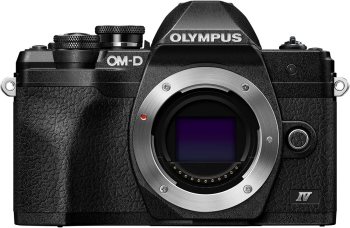- Excellent image quality
- Effective stabilization
- Rugged build
- User-friendly
- Compact and lightweight
- Affordable
- Complex menu system
- Expensive
- Limited advanced features
- Slower AF in low light
Olympus OM-D E-M1 Mark III vs Olympus OM-D E-M10 Mark IV
When it comes to Olympus cameras, two models that often come up in conversations among photography enthusiasts are the Olympus OM-D E-M1 Mark III and the Olympus OM-D E-M10 Mark IV. Both of these cameras belong to the esteemed OM-D series from Olympus, known for their exceptional quality, durability, and innovative features. However, they cater to different segments of the market, with the E-M1 Mark III being positioned as a professional-grade camera and the E-M10 Mark IV aimed more at enthusiasts and beginners. Let's dive into an in-depth comparison of these two models.
Body and Build
Olympus OM-D E-M1 Mark III: This camera boasts a robust, weather-sealed body designed to withstand harsh conditions, making it ideal for professional photographers who often find themselves shooting in unpredictable environments. The build quality is exceptional, with a comfortable grip that fits well in the hand, allowing for extended use without fatigue.
Olympus OM-D E-M10 Mark IV: While also weather-sealed, the E-M10 Mark IV has a slightly smaller and lighter body compared to the E-M1 Mark III. This makes it more appealing to those who prefer portability without sacrificing durability. The build quality is still very good, though it might not feel as premium as its higher-end counterpart.
Image Quality
Olympus OM-D E-M1 Mark III: Equipped with a 20.4-megapixel Live MOS sensor and the TruePic IX image processor, the E-M1 Mark III delivers outstanding image quality with excellent detail, color accuracy, and dynamic range. It's particularly renowned for its exceptional autofocus system, which includes phase-detection AF across the entire sensor area, making it superb for capturing fast-moving subjects.
Olympus OM-D E-M10 Mark IV: The E-M10 Mark IV features a 20.4-megapixel Live MOS sensor and the TruePic VIII image processor. While its image quality is very good, with crisp images and vibrant colors, it might slightly lag behind the E-M1 Mark III in terms of absolute detail and performance in low light conditions. However, for most users, especially those just starting out or looking for a versatile travel camera, the image quality will be more than satisfactory.
Autofocus
Olympus OM-D E-M1 Mark III: The autofocus system on the E-M1 Mark III is one of its standout features, with 121 phase-detection points covering most of the sensor area. This allows for incredibly fast and accurate focusing, even in challenging conditions or when tracking subjects.
Olympus OM-D E-M10 Mark IV: The E-M10 Mark IV also boasts an impressive autofocus system, though it uses a combination of contrast-detection and phase-detection AF with 121 points. While very capable, especially for static subjects or slower-moving objects, it might not match the E-M1 Mark III's speed and tracking capabilities.
Video Capabilities
Olympus OM-D E-M1 Mark III: This camera is quite versatile when it comes to video recording, offering up to 4K at 30fps (with no crop), along with excellent image stabilization thanks to its 5-axis system. It's a solid choice for videographers who need high-quality footage without the bulk of dedicated video equipment.
Olympus OM-D E-M10 Mark IV: The E-M10 Mark IV also records up to 4K at 30fps, and while it lacks the professional-grade features like OM-Log found on the E-M1 Mark III, its video capabilities are still very good for casual videography or vlogging. The image stabilization is also excellent, ensuring smooth footage.
Conclusion
Both the Olympus OM-D E-M1 Mark III and the Olympus OM-D E-M10 Mark IV are exemplary representatives of Olympus cameras, each with its own set of strengths tailored to different types of photographers. The E-M1 Mark III stands out as a professional tool with unparalleled autofocus performance, robust build quality, and features that cater directly to the needs of serious enthusiasts and professionals. On the other hand, the E-M10 Mark IV is an excellent choice for those looking for a more affordable, yet still highly capable, camera that doesn't compromise too much on features or image quality.
Ultimately, the decision between these two models will depend on your specific needs, budget, and the type of photography you engage in most frequently. Whether you're investing in your first Olympus camera or upgrading from an existing model, both the E-M1 Mark III and the E-M10 Mark IV offer compelling reasons to choose them, reflecting the high standards that Olympus cameras are known for.































